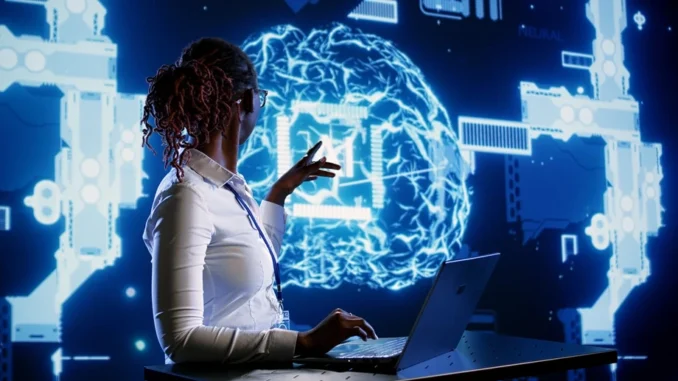
The future landscape of artificial intelligence (AI) is expected to be dynamic, evolving rapidly across various sectors and influencing numerous aspects of daily life. Here are some key trends and predictions that characterize the anticipated future of AI:
### 1. **Advancements in AI Technologies**- **General AI (AGI)**: Research aimed at developing artificial general intelligence that can understand, learn, and apply knowledge across a wide range of tasks will continue. While AGI is still theoretical, progress in broader AI capabilities is expected.










– **Enhanced Natural Language Processing (NLP)**: Future NLP models will likely become even more sophisticated, allowing for more natural and human-like interactions between humans and machines.
– **Improved Computer Vision**: AI in computer vision will see continued enhancements, enabling applications in areas such as autonomous vehicles, surveillance, and augmented reality.
### 2. **Ethics and Regulation**
– **Responsible AI Development**: As AI technologies advance, there will be more emphasis on developing ethical frameworks to ensure fairness, transparency, and accountability in AI systems.
– **Regulatory Compliance**: Governments and organizations will likely implement regulations for AI usage, particularly concerning data privacy, algorithmic transparency, and the impact of AI on employment.
### 3. **Increased Integration and Automation**
– **Industry Automation**: Sectors such as manufacturing, logistics, and agriculture will increasingly adopt AI-driven automation technologies to optimize processes and improve efficiency.
– **Collaborative Robots (Cobots)**: The deployment of cobots that work alongside human workers will grow, enhancing productivity without fully replacing human labor.
### 4. **Personalization and User Experience**
– **Tailored Solutions**: AI will provide increasingly personalized experiences in sectors like healthcare, education, and entertainment by analyzing individual preferences and behaviors.
– **Voice and Gesture Recognition**: Advancements in voice and gesture recognition will further facilitate seamless human-AI interaction, making technology more intuitive and accessible.
### 5. **Edge Computing and IoT**
– **Decentralized AI**: More AI computation will occur at the edge (on local devices), reducing latency and enhancing privacy, particularly with the growing adoption of IoT (Internet of Things) devices.
– **Smart Cities**: AI will play a crucial role in the development of smart cities, optimizing energy use, traffic management, waste management, and public safety.
### 6. **Healthcare Innovations**
– **Predictive Healthcare**: AI will enhance predictive analytics for patient care, enabling better preventive measures, personalized treatments, and real-time health monitoring.
– **Telemedicine**: The integration of AI into telemedicine will enhance diagnostics, remote monitoring, and patient management, particularly in underserved areas.
### 7. **Creative and Artistic Applications**
– **AI as a Creative Partner**: AI tools will increasingly serve as collaborators in creative fields, helping artists, musicians, and writers not only generate content but also explore new forms of expression.
– **Education and Training**: AI will play a vital role in education, providing adaptive learning environments that support diverse learning styles and needs.
### 8. **Interdisciplinary Collaboration**
– **Convergence of Disciplines**: The future of AI will see more interdisciplinary collaboration, combining insights from fields such as neuroscience, psychology, and ethics to create holistic AI solutions.
– **AI in Research and Development**: AI will accelerate research across various scientific domains, enhancing the discovery process in fields like materials science, pharmacology, and environmental science.
### 9. **Job Transformation and Workforce Dynamics**
– **Reskilling and Continuous Learning**: As AI automates routine tasks, workers will increasingly need to adapt by acquiring new skills. Lifelong learning and reskilling will become essential.
– **New Job Roles**: While AI may displace certain jobs, it will also create new roles focused on AI management, oversight, and integration into various industries.
### 10. **Global Competition and Collaboration**
– **Geopolitical Dynamics**: Nations will compete in AI research and development, leading to increased investment in AI technologies and talent. Simultaneously, international collaborations on ethics, standards, and AI safety might emerge to address global challenges.
– **Shared AI Platforms**: Development of open-source AI platforms could facilitate greater collaboration among researchers and organizations, democratizing access to AI technologies.
### Conclusion
The future landscape of AI holds immense potential for transforming industries, enhancing productivity, and improving quality of life. However, as AI continues to evolve, it will also pose significant challenges, particularly in terms of ethics, job displacement, and regulation. A proactive approach focusing on responsible development, transparency, and the equitable distribution of benefits will be crucial for harnessing AI’s potential while mitigating risks. As society navigates this rapidly changing landscape, collaboration among technologists, policymakers, and the public will be essential for shaping a future where AI positively impacts humanity.

Leave a Reply